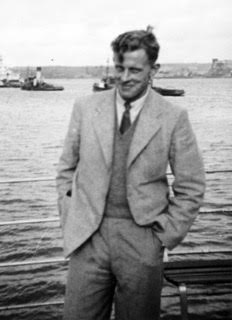WW2 100 - 9 January 1944 - ‘In proud and happy memory of a very greatly loved son’: Sergeant (Navigator) Robert Hugh Davis Watson (1923-44), Royal Air Force Volunteer Reserve, 131 Operational Training Unit (OTU)
Continued from 1 November 1943
Another Dalditch Camp Tragedy: Marine Arthur John Wilson (1925-43)
https://budleighpastandpresent.blogspot.com/2021/01/ww2-75-1-november-1943-another-dalditch.html
Budleigh Salterton War Memorial at the junction of Coastguard Road and Salting Hill
For many years Budleigh Salterton was famous as the favourite retirement place of Indian Army officers; the writer and former Budleigh resident R.F. Delderfield referred to it as The Curry. Robert Watson’s family background was very typical of this aspect of our town. He was the son of Lieutenant-Colonel Robert Arthur Davis Watson, OBE, Royal Engineers, and Ethel Douglas Watson.
His mother, born in Bengal in 1896 had grown up in India, where her father, John Henry Lace FRS, CIE, FLS (1857-1918) gained a distinguished reputation as a botanist. From 1881, Lace worked extensively in the Forest Service of India and became its inspector-general of forests. From 1908 to 1913 he served as chief forest conservator in Burma, making botanical collections in Afghanistan, Baluchistan as well as in India and Burma.
He was a Fellow of both the Linnean Society and the Royal Society. Many plant species epithets honour him. His extensive collections from Baluchistan formed the basis for ‘A Sketch of the Vegetation of British Baluchistan’, published in 1891 with W.B. Hemsley in the ‘Journal of the Linnean Society’. Lace completed the first forest-botanical checklist for Burma in 1912, a ‘List of trees, shrubs, herbs and principal climbers, &c. recorded from Burma with vernacular names’, which went through further editions. He spent his retirement in England and died at his home in Exmouth. When his daughter Ethel Douglas Lace married Robert Arthur Davis Watson in 1920, two years later, it was a relative, the Rev Walter Lace, who conducted the ceremony at Holy Trinity Church in Drewsteignton.
Robert’s father, Robert Arthur Davis Watson, was the only son of Major-General Sir Harry Davis Watson, KBE, CB, CMG, CIE, MVO (1866-1945), who had transferred to the Gurkhas after being gazetted lieutenant in the Dorsetshire Regiment in 1885, and had then had his first experience of active service with the Sikkim expedition of 1888, when British troops expelled Tibetan forces from Sikkim in north-east India.
General Sir John Watson VC, GCB Image credit: Wikipedia
Going further back in the
generations, Harry Davis Watson’s father was General Sir John Watson VC, GCB, (1829-1919) who
served with the Bengal Army and received his Victoria Cross for actions at
Lucknow during the Indian Mutiny.
General Sir
John Watson and family
Image credit: https://www.greatwarforum.org
Both Sir John Watson and Sir
Harry Davis Watson served members of the royal family – Sir John as Aide-de-Camp
to Queen Victoria, and Sir Harry as equerry to the Prince of Wales, who later
became George V.
So there were strong Indian Army as well as Devonian links in Robert Hugh Davis Watson’s distinguished family. Yet, as WW2 approached, he chose not the Army but the Royal Air Force Volunteer Reserve (RAFVR), which had been established in 1936 to support the preparedness of the Royal Air Force in the event of another war. His service number was 1339833.
Training as a navigator required specialist skills: the role involved keeping the aircraft on course at all times, reaching the target and then the home base. The navigator had to maintain a high level of concentration for virtually the whole of the flight, which could be up to seven hours.
A Consolidated PBY Catalina of No. 240 Squadron
based at RAF Stranrear as seen in 1941 Royal
Air Force official photographer, P.N.F.Tovey http://media.iwm.org.uk Photograph
CH 2448 from the collections of the Imperial War Museums
On 9 January 1944, John was one of a ten-man crew flying Consolidated Catalina FP193 of No. 131 Operational Training Unit. The Mark IB plane took off from RAF Killadeas, Co. Fermanagh at 0915hrs, taking part in a non-operational low-level bombing exercise, seemingly doing practice depth charge attacks.
Boa Island, County Fermanagh. Overlooking Lough Erne from the shore. Image credit: Kenneth Allen
While making a second run over Lough Erne, the plane dived into the water half a mile from Boa Island, Co. Fermanagh. Reports suggest the pilot failed to pull out of a diving turn. The water was calm, but flame floats (flares) on board the plane ignited as the plane went under, setting fire to the oil and petrol on the surface. Of the ten-man crew, seven died in the incident, including John. A further three occupants escaped with injuries.
A local resident claimed to have witnessed FP193 over the Lough, although he did not see the crash. He described the conditions that day as 'flat calm' and the Lough as 'like glass', suggesting that the pilot probably misjudged his height and went straight in.
The grave of Robert Hugh Davis Watson in Irvinestown Church of Ireland churchyard, Co Fermanagh, Northern Ireland Image credit: https://images.findagrave.com
Robert was 20 years old when he died. His body was recovered and buried at Irvinestown Church of Ireland churchyard. His headstone bears the inscription ‘In proud and happy memory of a very greatly loved son’.
The next post is for SERGEANT DANIEL GEORGE DICKS (1910-44) who died on 29 January 1944 in Italy while fighting with the 1/4th Battalion of the Hampshire Regiment. You can read about him at https://budleighpastandpresent.blogspot.com/2021/02/ww2-75-29-january-1944-very-gallant-old.html









Comments
Post a Comment